



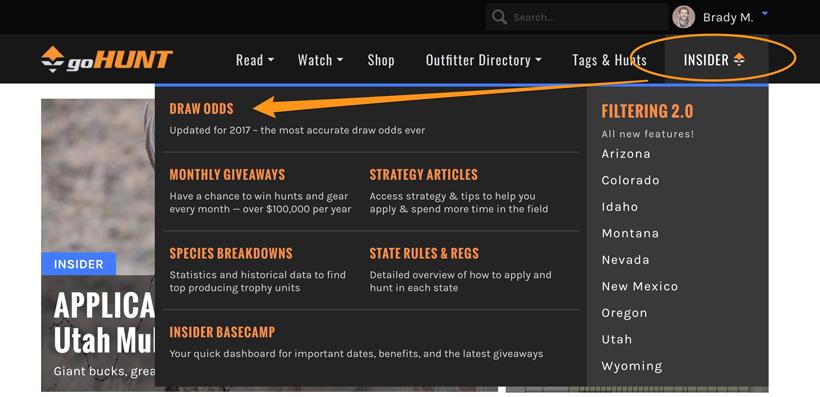
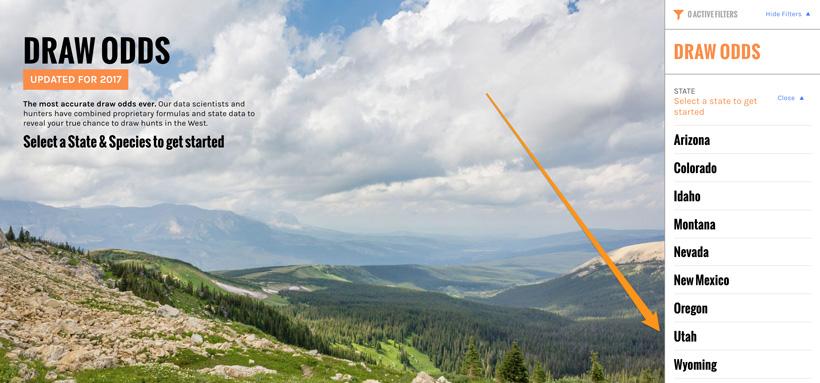
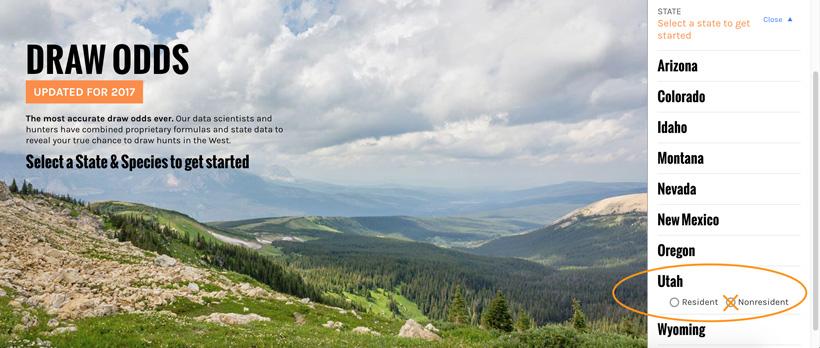

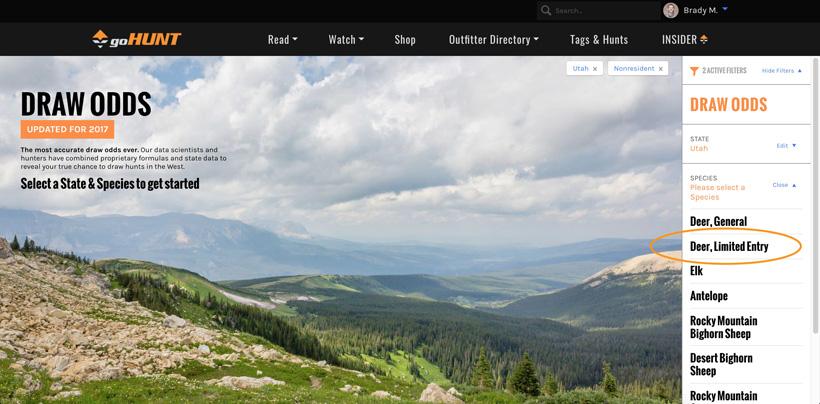
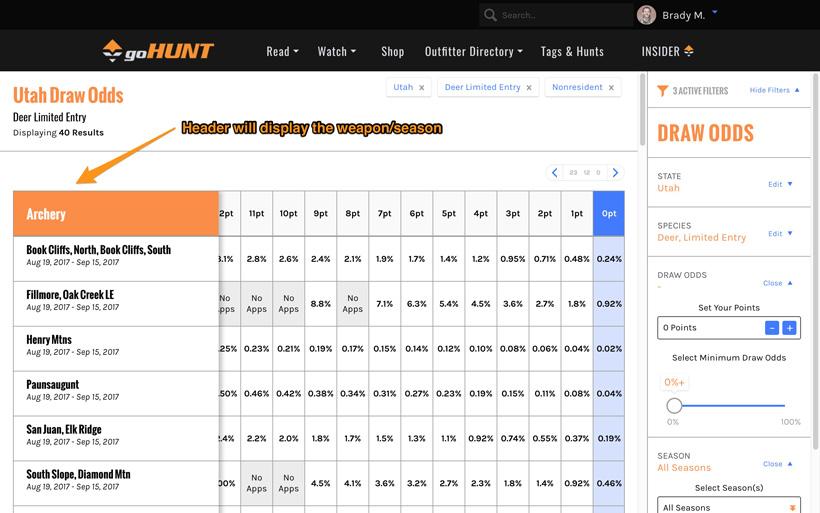
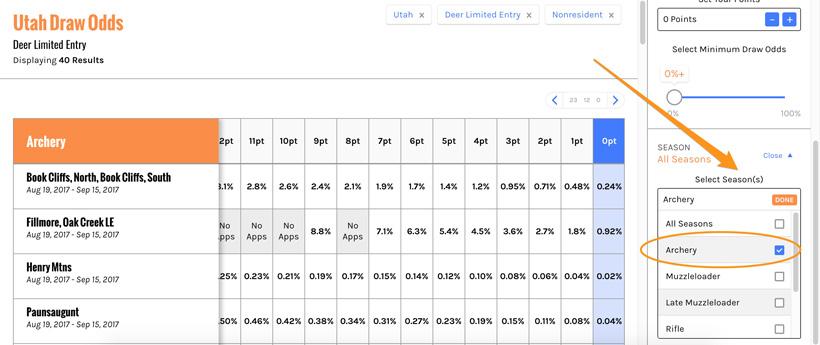

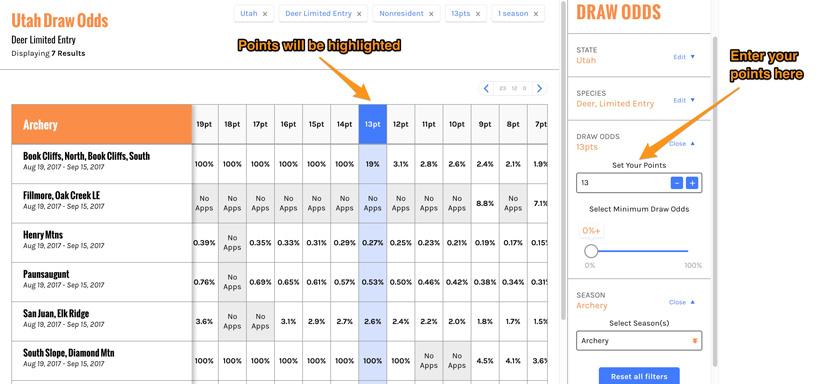
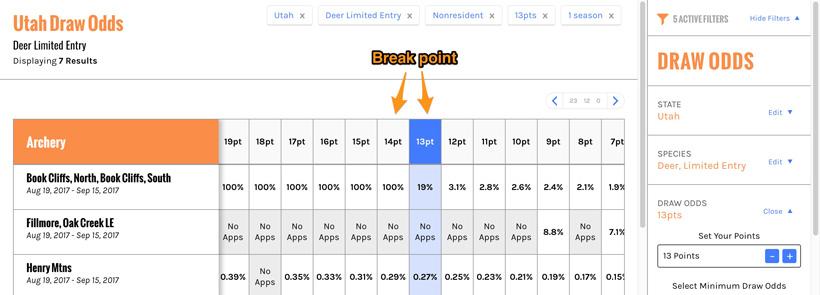
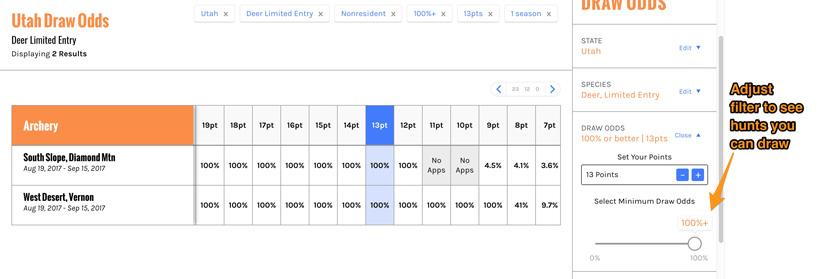
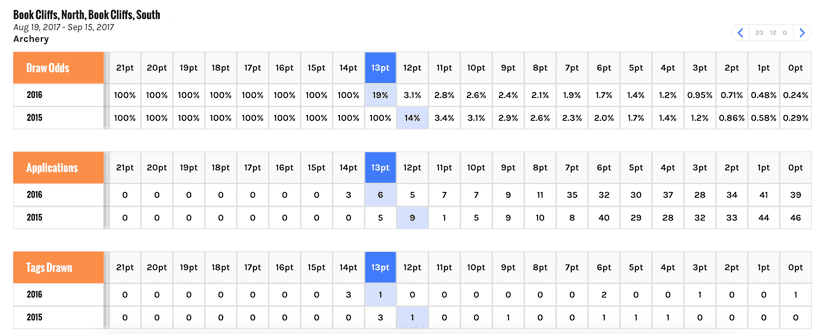

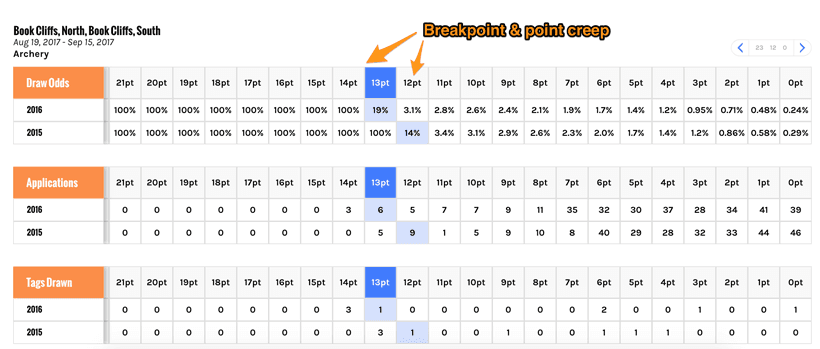
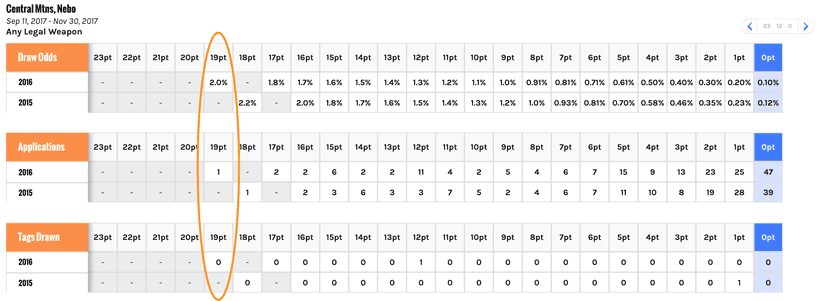
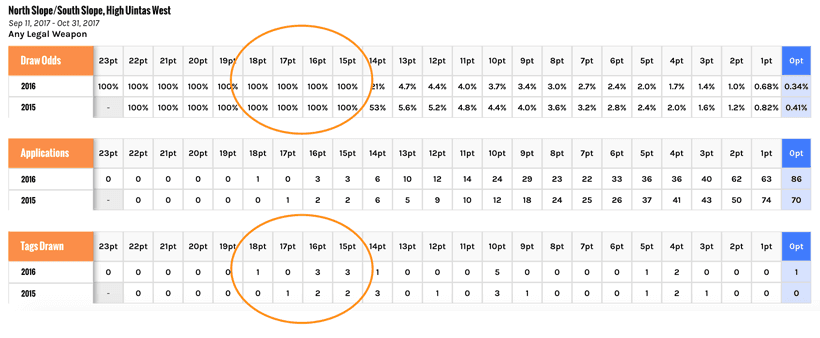
Knowing when you'll draw a tag and also how to draw more tags is essential to hunting more across the West. Our Draw Odds details page is perfect for seeing the big picture of how the draw process went. You can track trends, point creep, weapon by weapon odds, and see how many years it might take to draw a tag... all of which equal the ultimate tools for figuring out how to draw more tags. Draw Odds can be accessed in multiple places on Insider, but the details page is one of the most powerful sections.
To get started, navigate to the Insider dropdown menu on the upper right side of the screen and then click on the section that says "Draw Odds."
The next step is selecting a state and residency. For this example I am going to use Utah and nonresident.
Keep in mind that you can also select "Guided Draw" to see what the draw odds would be for entering in that draw. Note: A lot of times the draw odds in the Guided Draw are better than the main draw. Guided Draw odds are available in Nevada and New Mexico.
After you select a residency, you will then need to select a species. This is where the fun starts! For this example we're going to look at Utah, Nonresident, Deer, Limited Entry. The direct link if you want to follow along can be found here.
After you select a species, you'll be taken to the actual Draw Odds detail view. Like I mentioned before, this view is extremely powerful. If you're familiar with Filtering, you'll notice some similar filter options. There are many ways to go about the Draw Odds details view. Some people may just like to enter in their points and see what weapon the have the best draw odds for, while others might just want to see the draw odds for a certain weapon that they are comfortable with. There is no right or wrong way to go about using the tools on Draw Odds. It's all up to your personal preferences and goals.
In our example, we are starting with 40 different hunt options, but the great part about this view, is that we can quickly narrow our search down based on weapon choice and minimum draw odds.
If you're just concerned with an archery limited entry mule deer hunt, then on the right side where the filters are located, scroll down to Select Season(s) and select your season. Now we are only looking at seven results.
Now you will enter in your points in the Set Your Points filter on the right. I'm going to use 13 as an example. You can either type in 13 or use the plus or minus buttons. You will then see that your point level is highlighted. If you chose All Seasons, this highlight would show up across all weapon types. Note: Because draw odds are based on what happened the previous year, enter in your previous point total. Your view will look like the one below.
So now you can easily see your point level and draw odds through the entire weapon/season that we selected. You can use this to plan out the point break for states that use preference points. You'll see in the example above that for Book Cliffs, North, Book Cliffs, South archery you would have a 19% chance to draw the tag at 13 points, but one more point and you'd be 100%. This is the magical breakpoint level.
If you're trying to hunt this year, you should go over to the filters and adjust the Select Minimum Draw Odds filter to a higher value. This will then only show you hunts that you can draw at that percent and higher. For this example I am going to use 100%. Now we are showing two hunts that you could draw this year, based on your current point situation.
Now if you click on one of those units, you'll see the draw odds at every point level, how many people applied at every point level and how many tags were drawn at each point level. This is a great section to see point creep, the breakpoint, how many years it might take to draw a tag, and where random tags were drawn (for states that might have that option). Visually seeing the year-over-year draw odd trends is a very important feature. In the example below, I'm going to use Book Cliffs, North, Book Cliffs, South archery so we can see the breakpoint and the impact of point creep.
Once you are at the furthest point in the Draw Odds details page like in the example above, you can also scroll down and see how many residents and nonresidents are applying each year, how many tags they are giving out for each residency and some Unit Details (Avg. Quality, Trophy Potential, Harvest Success, Male:Female Ratio) and also click on the unit to jump into the Unit Profile. You can hover over the graphs to see the detailed information.
Next we will go into more details on point creep and the breakpoint.
Point creep happens all across the west. Basically it happens when more people start to apply for a unit (actually entering the draw after building points, unit is blowing up causing more people to apply, etc.) and there are less and less people drawing due to the limited amount of tags. Some cases it might only jump up a point, but other seasons could jump up two, three or even more points in one year.
Another example on why you should pay attention to the breakpoint and what units offer tags randomly or if they allocate some to max point holders.
According to the 2016 application records, there was one Utah resident with 19 mountain goat points that applied for the Central Mtns, Nebo hunt (a hunt that only has a random tag) that could have applied for the North Slope/South Slope, High Uintas West and successfully drew one of the maximum point permits.
Historically anyone over 15 points were drawing the tags in the max point pool in this example. Perhaps that wasn’t the hunt that person was looking for, but it illustrates the importance of reviewing your points, permit numbers and if that hunt offers permits to max point holders closely before applying.
The Draw Odds details page is also the perfect place to calculate how many more years it might take you to draw the tag if you're a few years behind the max point pool or just starting out. To do this you need to look at how many tags are given out at your residency each year and how many people are currently ahead of you. Note: make sure you are looking at an example that allocates tags to max point holders, this will do you no good if you're looking at a unit that only gives out tags randomly to a nonresident due to too few of tags. Each state is different in how they allocate tags.
Also, this will be rough estimate because you can never know how many people have been saving up points and are ready to enter the draw in this unit or how many people are going to switch from a different unit and start to apply in the unit you're trying to draw a tag for, death of applicants, or people switching out of this unit. Also this example assumes the same people keep applying and not switching over to building points, and that the state doesn't change the tag numbers or how they allocate tags.
In this Utah exampe, half of the tags go to the people with the most points and half of them go randomly.
Let's say you currently had 0 nonresident limited entry deer points for Utah and applied for the Book Cliffs, North, Book Cliffs, South archery in 2016 and you really want to draw a tag for this unit. You are currently 25 years old. As of 2016, there were 324 total people (including yourself) who applied for this hunt. Let's also say that you never draw a tag in the random draw while you're applying. Eight people will draw tags each year. How many years will it take until you draw this tag?
Unfortunately you will not draw a tag in the max points pool until 2057! That equals 42 total years of applying and if you started at age 25, you will now be 66 years old. I've mentioned this a lot before... but was it worth waiting that long to draw a tag? Or should have you looked at drawing an easier to draw unit? It all comes down to personal preference, but my strategy is always going on more hunts. So if this was your dream hunt, hopefully you were hunting in other states while you waited. But that also is the power of the Draw Odds details page to give you the tools to figure out what to apply for.
If you're wondering how we derive our Draw Odds numbers. You can check out the recent OFFSEASON episode we released recently below.
Best of luck in the draws. Let us know if you ever have any questions on how to navigate any of our tools on Insider. If you're unfamiliar with INSIDER, you can learn more below.